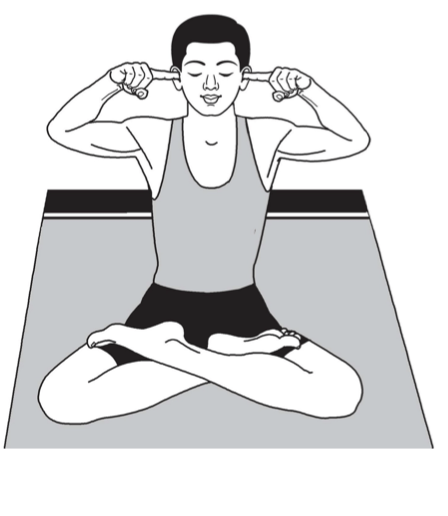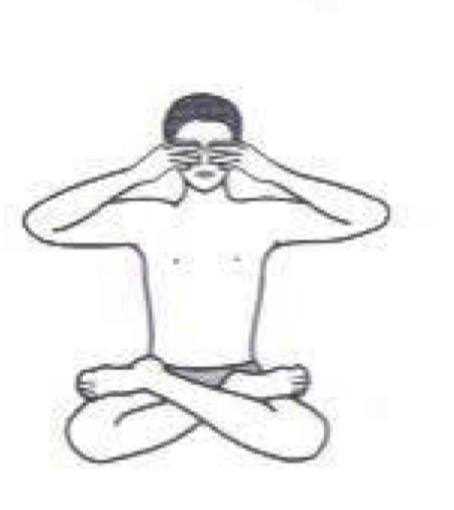Bhramari – Humming Bee Breath
Bhramari Pranayama Technique
Bhramari Pranayama, also known as Humming Bee Breath, is a calming breathing practice that soothes the nervous system and helps to connect us with our inner nature.
Bhramari is the Sanskrit word for “bee,” and this pranayama is so named because of the humming sound produced at the back of the throat during the practice like the gentle humming of a bee.
This exercise calms the nerves and thoughts and promotes concentration
Contraindications
It is contraindicated for people with extremely high blood pressure, epilepsy, chest pain, or an active ear infection. Bhramari should not be practiced in a supine position (lying down).
When to Practice
Bhramari (as with most pranayamas) is best practiced on an empty stomach. While it can be practiced at any time of day, Bhramari is particularly potent in the early morningand late at night—when there are fewer distracting noises and our inner perception is most acute.
Benefits Bhramari Pranayama:

- Calms and quiets the mind
- Releases cerebral tension
- Stimulates the pineal and pituitary glands, supporting their proper functioning
- Soothes the nerves
- Relieves stress and anxiety
- Dissipates anger
- Lowers blood pressure
- Strengthens and improves the voice
- Supports the healing of bodily tissues
- Induces sound sleep
Bhramari Pranayama Technique (easy)
Best to start with the following instruction:
- Close the ears with the index fingers and inhale.
- While exhaling through the nose, hum like a bumble-bee (the mouth remains closed).
- After about 5-7 breaths sit motionless and breathe normally with the ears still closed.
- Concentrate on your inner space and listen to the inner sound.
Instruction Bhramari Pranayama Technique Traditional
 1.Choose a comfortable sitting position. If you are able, it is best to sit cross-legged on the floor with a cushion or blanket to comfortably elevate the hips. Alternatively, you may choose to sit toward the front of a chair, with your feet flat on the floor. Allow the spine to lengthen so that the back, neck, and head are erect.
1.Choose a comfortable sitting position. If you are able, it is best to sit cross-legged on the floor with a cushion or blanket to comfortably elevate the hips. Alternatively, you may choose to sit toward the front of a chair, with your feet flat on the floor. Allow the spine to lengthen so that the back, neck, and head are erect.
2.Gently close the lips, keeping the teeth slightly apart, and bring the tip of your tongue to the space behind the upper front teeth. Maintain this position of the mouth throughout the practice, frequently checking to ensure that the jaw remains relaxed.
- Then, close each ear with the thumbs, place the index fingers at the midpoint of the forehead—just above the eyebrows—and reach the middle, ring, and pinky fingers across the eyes so that the tips of these fingers press very gently against the bridge of the nose.
- Take a long, deep breath in through the nostrils, bringing the breath all the way into the belly.
- Drop the chin to the chest and begin to exhale slowly, making a steady, low-pitched ‘hmmm’ sound at the back of the throat—like the humming of a bee.
Focus on making the sound soft, smooth, and steady. The positioning of the tongue allows the vibration to better resonate throughout the head, affecting the tissues of the brain. Keep the body completely still and bring your awareness to the center of the head—to ajna chakra—letting the sound fill the head and spread to the body.
Merge with the sound and allow the vibration to permeate your entire being.
At the end of the exhalation, slowly straighten your neck as you inhale again through the nostrils to repeat the process.
Begin with five to seven repetitions. You may either continue with five/seven repetitions, or you may add one repetition per week, slowly building up to a total of seventeen repetitions.
- After the final exhalation, allow your breath to return to normal and observe any changes that have occurred.
How do you feel physically, mentally, emotionally, and spiritually? What energetic shifts do you notice as a result of this practice? Where do you notice sensation in your body and how is it different from when you started?
- When you are ready, gently open your eyes, continuing to direct some of your awareness within.
Advanced practitioners sometimes add variations such as breath retention (khumbaka), muscular locks (bandhas), and may also hum on the inhalation as in ujjayi pranayama.


